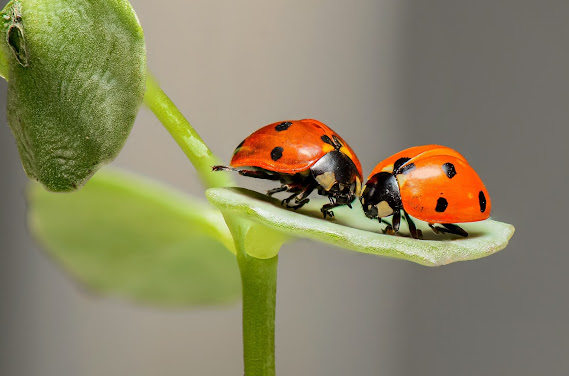Are Orange and Red ladybugs poisonous to humans or pets?
Ladybugs are without a doubt one of the most beautiful insects on the planet. They are available in a variety of hues and are typically nice and docile. But have you ever seen a ladybird that is orange? If so, you've undoubtedly encountered a certain sort of them. These orange ones are also known as Asian Lady Beetles, and they may bite and be aggressive, unlike their more docile counterparts. Ladybugs in general are not toxic or hazardous to humans. The orange ladybirds, on the other hand, have the greatest toxins in their bodies, which can cause allergies in some individuals and be lethal to animals. It is crucial to note that, although being more violent than the ordinary red ladybird, they only attack aphids, mealybugs, and other insects.
Do Orange Ladybugs Bite?
Ladybugs do not sting, but they can bite. Orange When compared to other colourful bugs, ladybirds contain the greatest poisons in their bodies. As a result, some people may experience an allergic skin response. Ladybugs may "pinch" their victims with their limbs in addition to biting them. They are not known to be human disease carriers. As a result, if one bites or pinches you, you should be OK.
Orange Ladybugs are helpful in the outdoors for pest management, but they may be a nuisance in the home. These insects generate a foul odour when disturbed. They also secrete yellow secretions that can stain surfaces. Orange ladybirds like to settle on garments and bite or pinch when they come into touch with humans. They have small, sharp teeth that allow them to eat and bite. It is pinprick-sized, seldom hazardous, and will most likely leave a red mark on the skin.
Are Orange Ladybugs Dangerous to Humans?
The Asian Lady Beetle was the obvious option for pest control. These orange ones were particularly violent, pinching and biting for no apparent cause. These insect-eating bugs, on the other hand, can infiltrate your home during the winter, searching for a warm and dry spot to live. They are not poisonous to people, and they are only detrimental to pets if they consume large quantities of them.
A foul-smelling yellowish material can also be secreted by the Asian Lady Beetle. It generally occurs when something is disrupted or smashed. Although it is not dangerous, it can stain clothes, walls, and furniture. It is difficult to remove stains and discoloration left behind by ladybirds in locations where they have been, and big infestations can cause severe damage when they penetrate homes or structures. You'll probably want to get rid of them before they come into your residence.
Are Orange Ladybugs Poisonous?
Orange ladybirds are Asian Lady Beetle members, and they are no more harmful than any other type. They have the same look as the other ladybirds, but they are much bigger. Although these orange ladybirds are not deadly to people, the toxic compounds they produce, known as alkaloids, can affect some animals.
A brighter hue on the backs of ladybirds indicates a larger dose of venom in their bodies. The more bright and eye-catching the colour, the more deadly and nasty its taste and odour would be, deterring predators. The pronotum, or region above its head, bears a distinguishing white mark that resembles a "M" or "W," which helps distinguish Asian Lady Beetles from other ladybirds.
It is worth mentioning that a single ladybird will not damage you, but ingesting a bunch of them would.
Are they poisonous to pets or livestock?
- behavioural modifications
- drooling \sdrowsiness
- not pooping (dogs cannot digest the hard shells of ladybirds, therefore impaction may occur)
- vomiting
Are Orange Ladybugs Dangerous to Dogs?
In the past, a dog's ingestion of ladybirds was connected to a variety of unfavourable outcomes. When dogs smash these orange ladybirds between their jaws, the lymph or fluid released can inflict damage comparable to a chemical burn. Furthermore, they might cause a burning feeling in the dog's intestines. Unfortunately, in extreme cases, it has the potential to kill dogs.
Asian Lady Beetles are a serious menace to canines because they infest in such large numbers. Dogs may easily consume enormous quantities of these as well. These orange ladybirds can cling to the roof of their mouths, causing chemical burns and blisters. Although you will need to peel the beetles off, it does not usually demand a trip to the emergency vet. In rare cases, eating or swallowing these ladybirds can be deadly, so keep your dogs away from them and examine their mouths often.
Ladybugs dislike chilly temperatures. As a result, they begin to spend more time indoors throughout the fall and winter seasons. They will begin to reappear in the spring and summer when they begin to feed on other soft-bodied insects or food found in houses, such as fruit, grain, and pollen.
Ladybugs are drawn to the following aspects of a home:
- wary, sunny areas
- light colors
- cracks in walls or attic spaces
- Sealing external gaps and holes through which ladybirds may potentially crawl.
- Putting screens over roof vents and inspecting present window screens for signs off.
- Damage planting mums and lavender, which are believed to naturally repel ladybirds
- Spraying pesticides like deltamethrin, cyfluthrin, cypermethrin, or tralomethrin around the house. Contact a pest specialist if you are unsure how to safely apply them.
- Installing light traps within your home. The brilliant light in these traps attracts ladybirds. After that, you can unload the ladybirds outside your house.
- Getting rid of dead ladybirds.
- Applying diatomaceous earth to your home's windows and doors. This soft sediment includes silica, which will dry up and kill ladybirds.









0 Comments